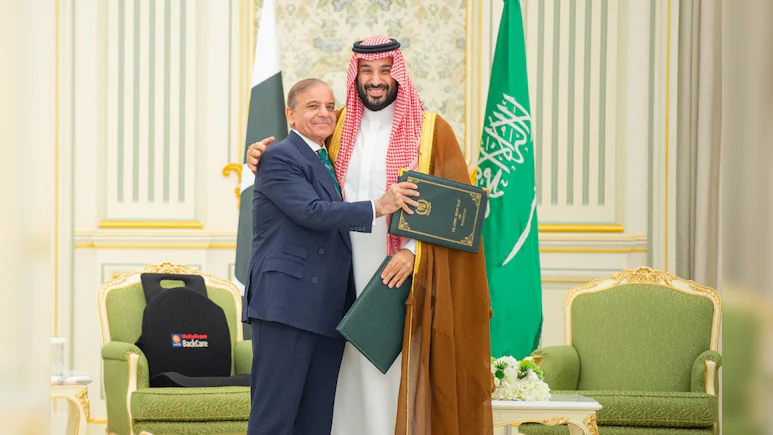
Punchline: When two allies pledge that a strike on one is a strike on both, the Gulf and South Asia’s fragile balance tilts into a new era of defense politics.
A Strategic Shift Announced in Riyadh
On September 17, 2025, Pakistan and Saudi Arabia signed a historic Strategic Mutual Defence Agreement in Riyadh. At the heart of the deal is a striking clause: “Any aggression against either country shall be considered an aggression against both.” The declaration elevates the longstanding partnership between the two nations into a formal defense pact, signaling stronger military and diplomatic coordination. This move comes at a time of heightened regional uncertainty, with multiple flashpoints across the Middle East and South Asia.
What the Clause Means
The pact’s core clause commits both nations to view any external aggression on one as a threat to the other. While the practical response—whether military, logistical, or diplomatic—has not been fully detailed, the symbolism of collective defense is powerful. The clause echoes mutual defense commitments seen in NATO treaties, marking an unprecedented moment in South Asia–Gulf relations. For many observers, it signals that Pakistan and Saudi Arabia are no longer content with informal assurances; they now want a binding framework that serves as both a deterrent and a statement of intent.
Historical Ties Turned Formal
Pakistan and Saudi Arabia have enjoyed decades of close cooperation. Pakistani troops have served in Saudi Arabia for training, internal security, and defense missions since the 1960s. Saudi Arabia has been a consistent supporter of Pakistan’s economy, providing aid, oil on deferred payments, and investments during times of financial crisis. In return, Pakistan has been a reliable partner in Saudi defense matters. This pact formalizes a relationship that has long been defined by brotherhood, religious affinity, and strategic need.
Regional Implications
The agreement is likely to be closely monitored across South Asia and the Middle East:
- India: New Delhi has responded cautiously, stating that it will assess the agreement’s implications for national security. While the pact formalizes existing ties, it could influence India’s calculations in both South Asia and the Gulf, particularly with regard to its energy security and diaspora interests.
- Iran: As a regional rival of Riyadh and, at times, Islamabad, Tehran is expected to view this pact as a potential counterweight to its own influence in the Gulf. The Iran–Saudi rivalry could see new dimensions, especially if Pakistan is drawn into Saudi strategic concerns over Yemen or the Strait of Hormuz.
- China and the U.S.: Beijing, already a close partner of Pakistan, may see this pact as an opportunity to expand its Belt and Road footprint through trilateral cooperation. Washington, which has defense ties with Riyadh, will study whether the pact affects its own leverage in the region.
Challenges and Ambiguities
Despite its strong language, the pact leaves certain questions unanswered:
- Definition of aggression: Does it include cyberattacks, drone strikes, or proxy warfare, or is it limited to conventional military invasion?
- Obligations in practice: Will Pakistan automatically deploy forces in the event of Saudi conflict, or will it limit support to intelligence sharing and logistics?
- Risk of entanglement: Could either country be drawn into conflicts it would otherwise avoid, for example, a direct Saudi–Iran confrontation or a South Asian flashpoint involving Pakistan?
Economic and Security Dimensions
Beyond military considerations, the pact has strong economic undercurrents. Saudi Arabia remains one of Pakistan’s largest sources of remittances, with millions of Pakistani workers in the Kingdom. The pact may enhance security guarantees for this diaspora. On the flip side, Saudi investments in Pakistan’s energy and infrastructure sectors could accelerate, backed by the confidence of a stronger political and defense alliance.
A Message of Deterrence
Supporters of the agreement argue that it strengthens deterrence by raising the cost of aggression against either country. The message is clear: external actors must now calculate the risk of facing two states instead of one. However, critics caution that such sweeping commitments could increase regional tensions and risk miscalculation, especially in a region already marked by proxy wars and shifting alliances.
Looking Ahead
The Pakistan–Saudi pact is expected to result in:
- Expanded joint military exercises and training programs.
- Greater intelligence and defense technology cooperation, including possible missile defense coordination.
- Broader alignment on regional crises, ranging from Yemen and the Red Sea to Afghanistan and Kashmir.
- Potential formation of a Gulf–South Asia security corridor that links energy flows with defense guarantees.
By declaring that an attack on one is an attack on both, Pakistan and Saudi Arabia have not only reshaped their bilateral relationship but also injected a new layer of complexity into the security chessboard of South Asia and the Gulf. Whether this pact becomes a stabilizing force or a trigger for fresh rivalries will depend on how its bold words translate into concrete action.
FOR MORE BLOGS – beyondthepunchlines.com

 Add to favorites
Add to favorites








